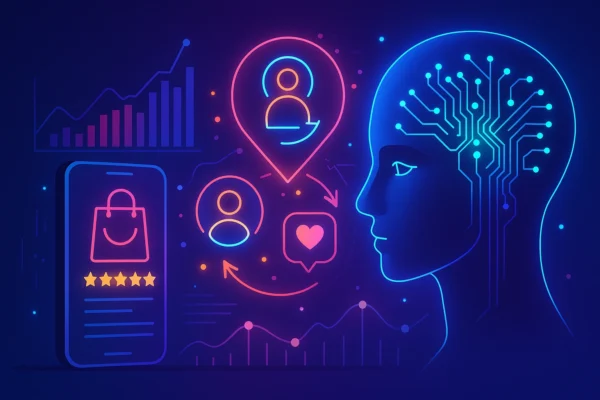
In 2025, the battle for consumer loyalty has shifted from broad personalization to hyper-personalization, a sophisticated strategy that leverages artificial intelligence (AI), real-time data, and contextual intelligence to deliver deeply individualized customer experiences. Unlike traditional personalization, which often relies on static customer segments or historical data, hyper-personalization dynamically adapts to each customer’s behavior, preferences, and context in real time. This approach is transforming industries like automotive, retail, and e-commerce, driving operational efficiency, enhancing customer retention, and redefining competitive advantage. We try to explore here the mechanics, technologies, applications, ethical challenges, and future trajectory of hyper-personalization, with some examples to illustrate its transformative power.
What is Hyper-Personalization?
Hyper-personalization is the use of advanced AI, machine learning (ML), behavioral analytics, and contextual data to craft one-to-one customer experiences that feel intuitive and seamless. It goes beyond traditional personalization by incorporating real-time, multidimensional data points to anticipate and fulfill customer needs at the precise moment they arise. Key components include:
Real-time user behavior: Tracking actions such as browsing patterns, clicks, or cart abandonment to tailor experiences instantly.
Example: Netflix adjusts its homepage content in real time based on a user’s scrolling speed and hover time over thumbnails, prioritizing genres or titles that align with their immediate engagement patterns.Geolocation and device signals: Using location and device type to contextualize recommendations.
Example: Starbucks’ mobile app detects a customer’s proximity to a store and sends a push notification with a personalized offer, such as a discount on their favorite latte, timed to coincide with their usual coffee break.Customer sentiment: Analyzing text, voice, or facial expressions to gauge emotional states.
Example: A virtual assistant in a banking app detects frustration in a customer’s voice during a support call and escalates the query to a human agent while offering a tailored apology and a fee waiver.Micro-moments: Factoring in transient conditions like time of day, weather, or mood to fine-tune interactions.
Example: A fitness app like Fitbit suggests a quick indoor workout instead of a run if it detects rainy weather in the user’s location, aligning with their schedule and preferences.
The outcome is a fluid, adaptive customer experience where recommendations, content, and services evolve as the customer interacts with the brand, fostering a sense of being uniquely understood.
From Personalization to Hyper-Personalization: The Evolution
The shift from traditional personalization to hyper-personalization reflects a broader transformation in customer experience management, moving from reactive, one-size-fits-many approaches to proactive, context-driven engagement.
Traditional Personalization
Static and rule-based: Relies on predefined rules, such as inserting a customer’s name in an email or segmenting based on gender or age.
Example: A retailer sends an email saying, “Hi Sarah, check out our women’s clothing sale!” based solely on the customer’s name and gender.Based on historical data: Uses past purchases or demographic data to make broad assumptions.
Example: Amazon recommends a laptop bag to a customer who bought a laptop six months ago, without considering their current needs.One-way communication: Brands push messages without real-time feedback loops.
Example: A travel agency sends a generic promotional email about beach vacations to all customers who booked trips in the past year, regardless of their current interests.
Hyper-Personalization
Dynamic and context-aware: Adapts to real-time signals and evolving customer contexts.
Example: Spotify’s Discover Weekly playlist not only considers a user’s listening history but also incorporates their recent skips, time of day, and even the mood inferred from their playlist choices (e.g., upbeat tracks for morning commutes).Uses real-time behavioral data and AI prediction models: Anticipates customer actions based on live interactions.
Example: An e-commerce platform like ASOS adjusts product recommendations mid-session if a user shifts from browsing casual wear to formal attire, predicting their intent to shop for an event.Enables two-way, responsive engagement: Facilitates interactive dialogues through AI-driven tools.
Example: Sephora’s chatbot asks a customer about their skin type and preferences, then suggests a tailored skincare routine, updating recommendations if the customer expresses concerns about sensitive skin.
This evolution aligns with the shift from Customer Relationship Management (CRM)—focused on storing and managing customer records—to Customer Experience Management (CXM), which prioritizes anticipating and shaping customer needs in real time.
Technologies Powering Hyper-Personalization
Hyper-personalization relies on a robust ecosystem of AI-driven technologies that process vast amounts of data to deliver precise, timely, and relevant experiences. Key technologies include:
Generative AI : They create tailored content on the fly, from marketing copy to chatbot responses, enhancing engagement.
Example: A travel platform uses generative AI to craft a personalized email for a user, suggesting a weekend getaway to a nearby city with activities (e.g., hiking or museums) based on their past bookings and recent searches, written in a tone that matches their communication style.
Customer Data Platforms (CDPs) : CDPs consolidate data from multiple touchpoints (web, mobile, in-store, call centers) to create unified, real-time customer profiles.
Example: A retailer like Target uses a CDP to merge a customer’s online browsing history, in-store purchases, and loyalty program data, enabling the app to suggest complementary products (e.g., matching shoes for a recently viewed dress) during their next visit.
Natural Language Processing (NLP): NLP interprets customer sentiment, intent, and context from text or voice interactions, enabling emotionally intelligent responses.
Example: A telecom provider’s virtual assistant detects sarcasm in a customer’s complaint about slow internet (“Wow, this speed is just amazing!”) and responds empathetically, offering a discount and scheduling a technician visit.
Behavioral Tracking and Predictive Analytics: These tools monitor customer interactions and use ML to predict future actions, such as purchases or churn.
Example: A subscription service like Adobe Creative Cloud tracks a user’s activity (e.g., frequent use of Photoshop but not Illustrator) and predicts they’re likely to upgrade to a premium plan, prompting a timely offer for a discounted bundle.
Together, these technologies create a feedback loop where data is continuously collected, analyzed, and acted upon, ensuring experiences remain relevant and impactful.
Sectoral Use Cases
Hyper-personalization is reshaping industries by embedding AI-driven insights into every customer touchpoint. Below are detailed applications in automotive, retail, and e-commerce.
Automotive
Connected Vehicles and In-Car Experience AI integrates driver data (e.g., driving patterns, preferences) with vehicle telemetry to personalize the in-vehicle experience.
Example: Tesla’s AI-driven interface learns a driver’s habits, such as preferring podcasts during morning commutes, and automatically queues a new episode of their favorite show when they enter the car at 8 a.m. It also adjusts seat positions and climate settings based on the driver’s profile and outside weather.
Predictive Maintenance and Post-Sale Engagement Manufacturers use real-time vehicle data to anticipate maintenance needs and offer tailored services.
Example: BMW’s connected car system monitors engine performance and driving conditions, sending a notification about an upcoming oil change with a personalized service package (e.g., tire rotation included for high-mileage drivers) and a booking link for the nearest dealership.
Retail
In-Store Experience Meets Digital Intelligence AI enhances physical retail by combining in-store tracking with digital insights to create seamless experiences.
Example: Nike’s flagship stores use AI-powered cameras and RFID tags to track shopper movements. If a customer lingers at a running shoe display, their loyalty app pushes a coupon for those shoes, tailored to their size and color preferences from past purchases.
Dynamic Pricing and Promotions Retailers adjust prices and offers in real time based on customer behavior and market conditions.
Example: A grocery chain like Kroger uses AI to offer dynamic discounts on a customer’s favorite yogurt brand if they haven’t purchased it in weeks, detected via their loyalty card, while factoring in current inventory levels to avoid overstock.
e-Commerce
Intelligent Product Discovery AI-driven recommendation engines personalize product searches based on real-time interactions and preferences.
Example: Etsy’s search algorithm notices a user clicking on handmade pottery with earthy tones and prioritizes similar items in their feed, while also suggesting complementary products like artisanal tableware based on their browsing history.
Hyper-Relevant Email and Notification Strategy Notifications are timed and tailored to maximize engagement, avoiding generic blasts.
Example: An online bookstore like Bookshop.org sends an abandoned cart email to a user who left a sci-fi novel in their cart, but only if they haven’t purchased it elsewhere. The email includes a 10% discount and a recommendation for a new release by the same author, sent at 7 p.m. when the user typically browses.
Privacy vs. Personalization: Navigating the Tightrope
Hyper-personalization’s reliance on extensive data collection raises significant privacy concerns. In 2025, balancing personalization with ethical data use is a top priority for brands and regulators alike. Key practices include:
Zero-party data collection: Encouraging users to share preferences directly in exchange for tailored experiences.
Example: A beauty brand like Glossier prompts users to complete a quiz about their skin type and makeup preferences, offering a customized product bundle in return, ensuring data is willingly shared.Edge AI: Processing data locally on devices to minimize data transfer and enhance security.
Example: Apple’s Siri processes voice commands on-device for personalized reminders (e.g., suggesting a grocery list based on past purchases) without sending sensitive data to the cloud.Transparent AI: Explaining why specific recommendations are made to build trust.
Example: A streaming service like Hulu includes a “Why this ad?” link next to personalized movie suggestions, showing users that the recommendation is based on their recent viewing of similar genres.
Regulatory frameworks, such as the EU’s AI Act and India’s Digital Personal Data Protection (DPDP) Bill, mandate transparency and accountability in AI-driven decisions. Companies are adopting consent orchestration platforms to automate compliance, ensuring customers can easily manage their data preferences.
Example: A multinational retailer like Walmart uses a consent platform to let customers opt in or out of personalized ads via a single dashboard, with clear explanations of how their data will be used.
Future Outlook: From Reactive to Predictive to Proactive
Hyper-personalization is evolving through three stages:
Reactive: Responding to customer actions in real time.
Example: A food delivery app like DoorDash suggests restaurants based on a user’s current order, adjusting options if they remove an item from their cart.Predictive: Anticipating customer needs based on patterns.
Example: A fitness tracker like Whoop predicts a user might skip their workout due to a late-night sleep pattern and suggests a lighter yoga session instead.Proactive: Initiating actions to guide customers before they act.
Example: A banking app like Chime notices a user’s recurring coffee shop purchases and proactively offers a cashback deal with a partnered café, nudging them to save.
By 2027, industry forecasts suggest that 70% of customer experience initiatives in mature enterprises will be AI-led, with hyper-personalization becoming the standard rather than a differentiator.
Hyper-personalization is no longer a futuristic vision—it’s a strategic imperative for 2025. For industries like automotive, retail, and e-commerce, the ability to sense, adapt, and serve customers in real time is a game-changer. The infrastructure—AI, CDPs, NLP, and predictive analytics—is in place. The data is abundant. The challenge lies in aligning organizations around a customer-centric ethos that prioritizes context over convenience.
Brands that invest in hyper-personalization today will not only capture loyalty but also set the pace for a future where every interaction is meaningful, predictive, and deeply human. The question isn’t whether to adopt hyper-personalization—it’s how quickly you can make it your competitive edge.
Further Readings on Hyper-Personalization
Salesforce: Hyper-Personalization Unlocks Customer Loyalty
https://www.salesforce.com/blog/why-hyper-personalization-is-the-future/IBM: What is Hyper-Personalization?
https://www.ibm.com/topics/hyper-personalizationMcKinsey: The Vision for 2025: Hyperpersonalized Care and ‘Care of One’
https://www.mckinsey.com/business-functions/operations/our-insights/the-vision-for-2025-hyperpersonalized-care-and-care-of-one





